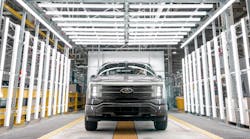Ford to Lean Primarily on Price Increases to Offset Rising Costs
Helped by improved manufacturing rates in March and strong demand that they think will support more price increases, Ford Motor Co. on April 27 said it is maintaining its 2022 pre-tax profit forecast.
Ford posted a net loss of $3.1 billion in the first quarter—the company marked down the value of its investment in electric truck maker Rivian by $5.4 billion to $5.1 billion—on sales of $34.5 billion, which were 5% lower from the prior-year period. Adjusted earnings before interest and taxes were $2.3 billion versus $3.9 billion early last year. The company sold about 966,000 vehicles during the quarter, down from about 1.1 million both late last year and in the first three months of 2021, and still expects to grow its wholesale volumes 10% to 15% from 2021.
CEO Jim Farley and CFO John Lawler told analysts and investors the automaker wasn’t spared by supply chain and inflationary pressures in the first quarter: Ford’s spending on commodities this year is now expected to be $4 billion higher than previously forecast and about 53,000 nearly-completed vehicles are awaiting semiconductors.
But consumers are still asking for more product and Ford finished the first quarter with $17 billion worth of orders on its books. (That includes 200,000 reservations for the F-150 Lightning EV pickup on which the company this week started full production at its Rouge Complex.) Farley and Lawler said they have been raising prices and plan to continue to use that lever as their main tool for offsetting higher costs while also looking to cut more costs across the newly organized Ford Blue unit for internal-combustion engine vehicles.
“We are being very aggressive in ramping up additional cost efforts because we don’t believe … inflationary pressures are easing up soon,” Lawler said while Farley noted that a streamlined Blue lineup will present cost-cutting options not just in manufacturing and engineering but also in marketing and sales and other areas of the business.
Asked if, as their peers at General Motors Corp. said a day earlier they do, Ford executives have the option to delay some growth investments as a way to defray rising costs, Farley was emphatic in saying no and reiterated his team’s goal of having an efficient Ford Blue fund the growth of the Model e division developing EVs.
“Our Ford+ plan is so specific as to where to invest,” he said. “It’s all about improving productivity of our base business.”
Shares of Ford (Ticker: F) rose about 1% to roughly $15 in after-hours trading April 27. Year to date, they’ve lost about 30% of their value, cutting Ford’s market capitalization to about $60 billion.




